INTRA-ARTICULAR DISLOCATION FRACTURES OF THE MIDDLE PHALANX BASE - CASE REPORTS OF INCORRECT TREATMENT PROCEDURES, CURRENT TREATMENT CONCEPTS
Authors:
Jan Dušátko; Pavel Pilař
Authors place of work:
Ortopedicko-traumatologické oddělení Nemocnice Prostějov
Published in the journal:
Úraz chir. 26., 2018, č.4
Summary
INTRODUCTION: Fractures of the base of the middle phalanx of the hand include the entire spectrum of injuries. They can be divided into fractures of the volar part of the base of the phalanx at the place where the metacarpophalangeal volar plate is attached, fractures of the dorsal part of the base of the phalanx at the insertion point of the central extensor band, or complex fractures of the pilon. The paper presents case reports that point to possible errors in diagnosis and treatment. Furthermore, an overview of current therapeutical concepts is presented.
DISCUSSION: The treatment method is based on the evaluation of the stability of the proximal interphalangeal joint. Stable injuries are treated conservatively, unstable fractures require surgical treatment. For conservative treatment, functional therapy is preferred. Possibilities of treatment of unstable injuries include open reduction and osteosynthesis, closed reduction and stabilization by dynamic external fixation, or more advanced methods of reconstruction, such as volar plate arthroplasty and hemi-hamate arthroplasty.
CONCLUSION: Quality diagnostics, surgeon‘s erudition and material equipment are essential for successful treatment. Despite proper treatment, full functional recovery is usually not achieved. The aim of therapy is the patient´s functional and painless finger.
Keywords:
Proximal interphalangeal joint – PIP – dislocation fractures
INTRODUCTION
Injuries in the area of the proximal interphalangeal joint of the fingers of the hand are often encountered in the trauma emergency ward. In most cases, the distortion of the joint is caused by the hyperextension mechanism, for example in ball games, where the volar disc is injured with or without the abruption of the bone fragment from the base of the base of the middle phalanx. Diagnosis and treatment of these injuries usually do not cause problems and are successfully conservatively treated. However, serious injuries may occur in the area of articular surface. Then it is a more complicated case often requiring a surgical solution. In the initial treatment, this damage may be underestimated or even undiagnosed. The aim of this work is to point out some errors that may occur in the diagnosis and treatment of these injuries in the form of case reports and to give a brief overview of current therapeutical concepts.
CASE REPORTS
Case report 1
A man, aged 46, injured his left hand by falling off a bike. On the day of the injury he was treated at a traumatology clinic. According to the clinical examination the little finger pain is dominant and mobility practically equals zero for the reason of the pain. A standard left hand X-ray was made and evaluated as negative (Fig. 1). Targeted projection to finger V was not performed. Antalgic gypsum fixation to finger IV - V in physiological position was applied and the patient was invited in 2 weeks time for review. At the same time, due to conspicuous defiguration and persisting movement restriction, a control X-ray of the little finger was performed with the finding of abruption of the volar part of the base of the middle phalanx with a fragment of approx. 50 % of articular surface, which is dislocated by pulling the volar plate proximally to the area of A2 peritenon and with dorsal dislocation in PIP (Fig. 2). Patient admitted to surgical intervention. The procedure took place the following day, i.e. 15 days after the accident. From the volar approach, the retracted volar plate was penetrated to, the bone fragment was cominutive and unsuitable for refixation, therefore the volar plate was sutured through and re-fixed to the middle phalanx by means of a transoseal stitch, thus achieving a reduction. It was resecured by transfixing of the PIP joint with K wire in moderate semiflexion (Fig. 3). Post-operatively, the finger was fixed in a plaster splint, which was removed after 3 weeks time with the Ki wire. The total fixation time was therefore more than 5 weeks. Thereafter, controlled rehabilitation was initiated, and was terminated after 3 weeks at the patient‘s request. The final active movement in PIP S 0-20-70, in DIP S 0-0-20, the patient was subjectively satisfied, did not attend the planned follow-up check.
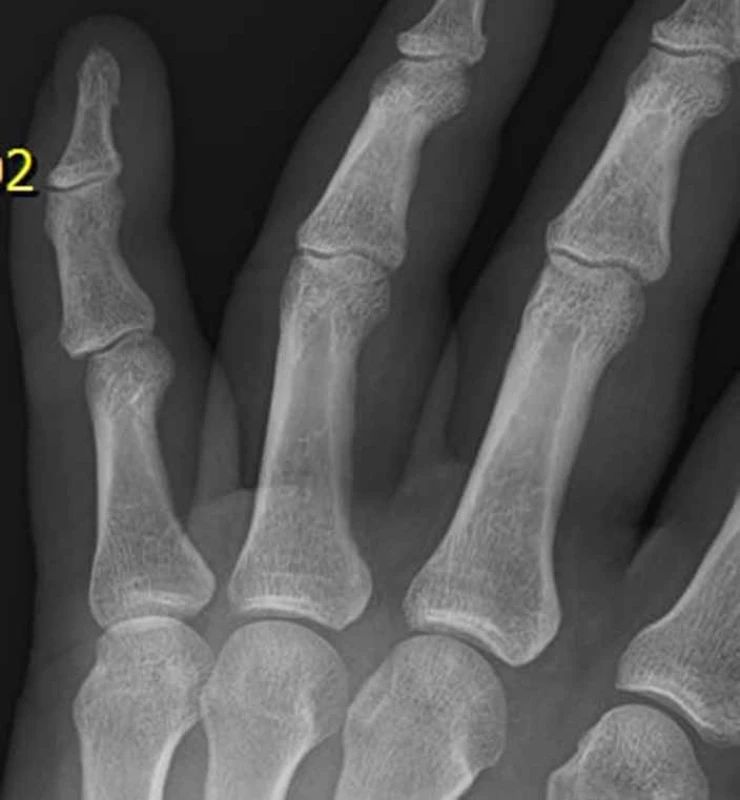
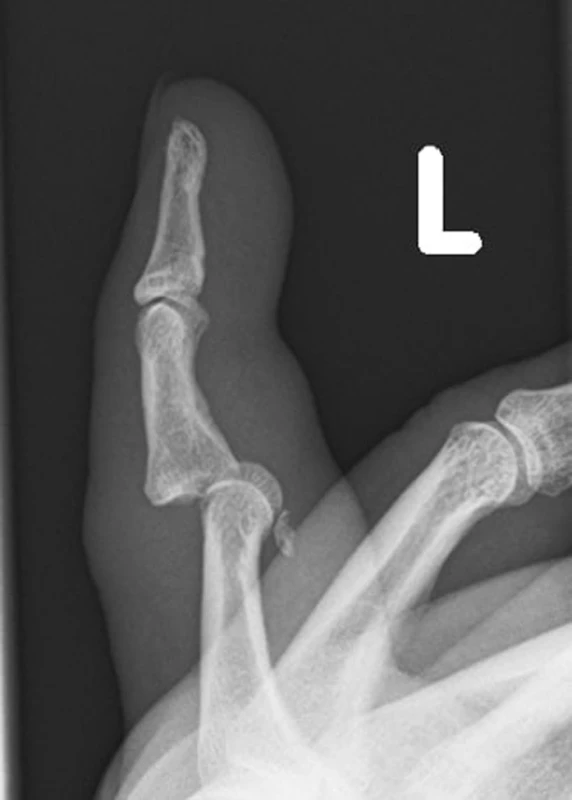
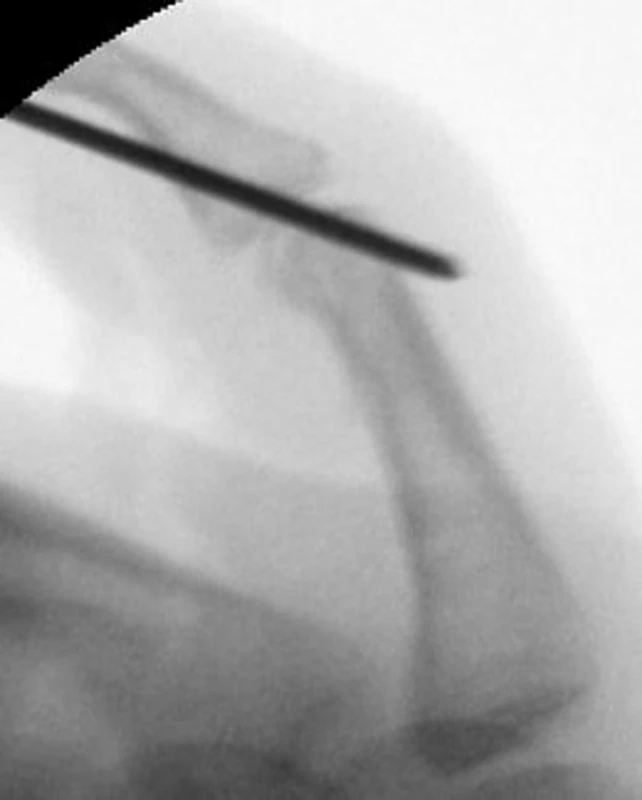
Case report 2
A 59 year old woman injured her finger IV of the upper right extremity by falling in a forest. On that day, she was treated at an emergency clinic. Clinical examination revealed swelling and movement limitation of the PIP joint movement. The right hand X-ray revealed abruption of the base of the middle phalanx of the finger IV (Fig. 4). Gypsum splint was applied on finger IV and V and the patient was invited for a check in one week´s time. The procedure included a check-up X-ray performed in the plaster splint - repeated AP and oblique projection - and they were evaluated as a stationary position. The plaster was removed and ALU splint was applied, the review image was not taken, the patient was invited for a check after 9 days. Here an image targeted on finger IV was made (Fig. 5). Dorsal and slightly ulnar subluxation of the PIP joint and a defect in the articular surface of about 50 % are apparent. The time elapsed from the accident is 16 days. The patient was admitted for the surgery that day. Penetration through the volar approach into the PIP joint was made, the bone fragment was nonrefixable, therefore, arthroplasty of the volar plate using a transosseal stitch and with the extension block of PIP joint using one Ki wire was made (Fig. 6). Gypsum fixation was left after the surgery; it was removed after another 3.5 weeks along with Ki wire and controlled rehabilitation was initiated. This was applied intermittently for 3 months. Final active mobility reached in PIP S 0-30-70, in DIP S 0-0-0. The patient is right-handed, unemployed, subjectively negates the pain, mobility restriction causes discomfort, but she can handle normal everyday activities.
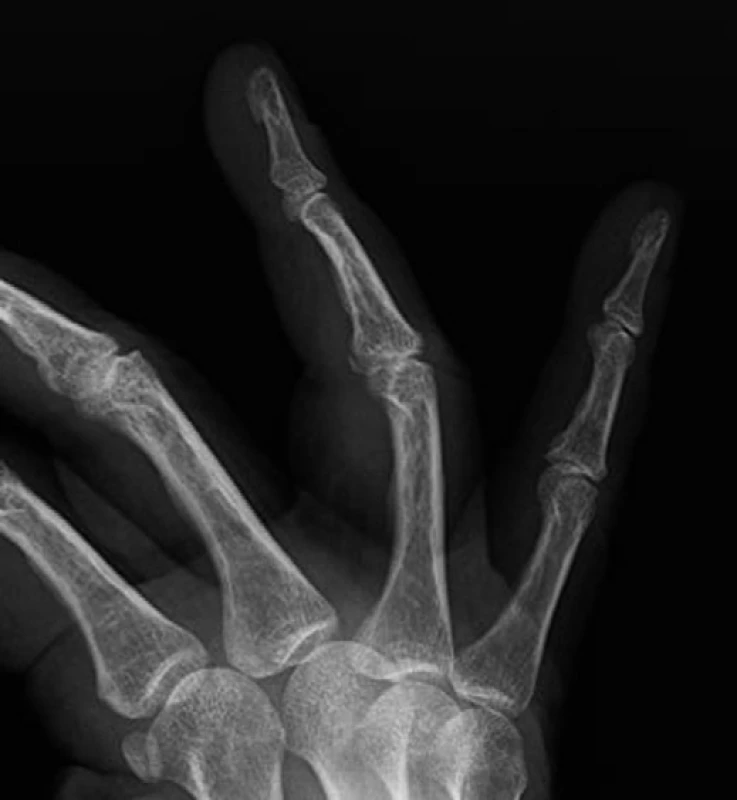
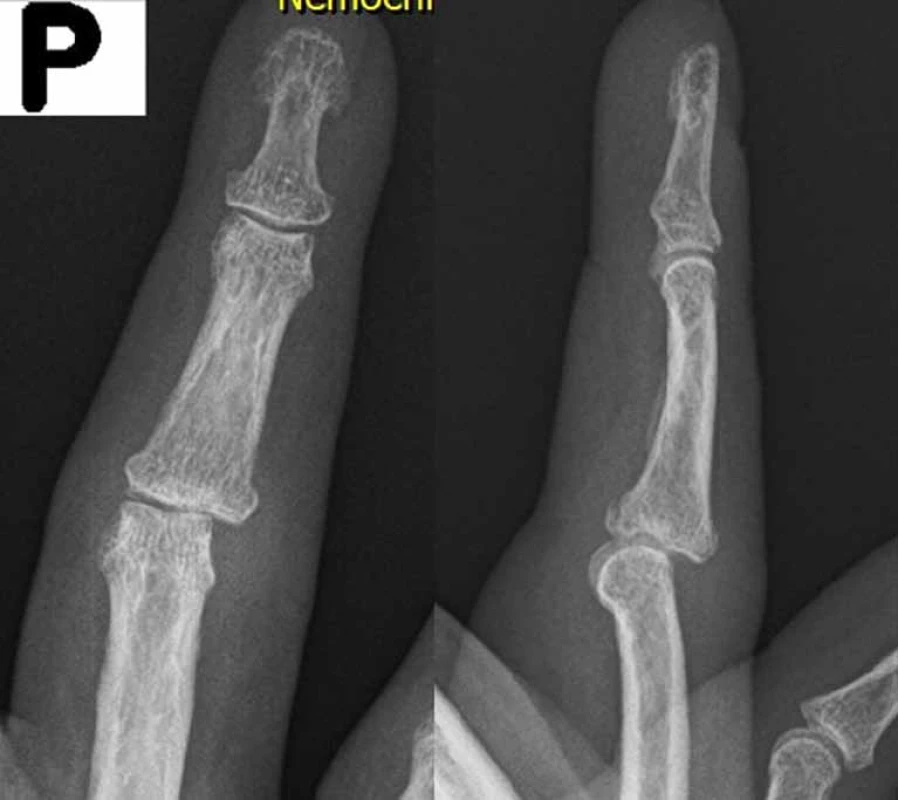
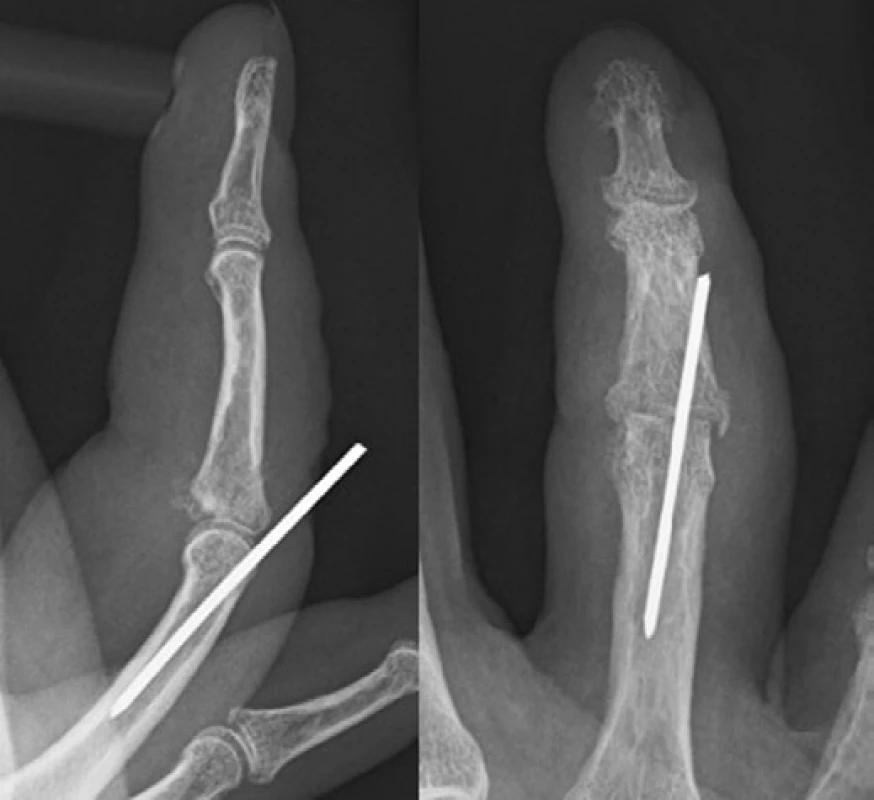
Case report 3
A 57-year-old woman injured her left upper limb finger IV through a distortion mechanism when handling a package. On the day of the injury she was treated at a traumatology clinic. On the X-ray, fracture of the volar part of the base of the middle phalanx was diagnosed, which affected more than 50% of the articular area with dorsal subluxation in PIP (Fig.7). CT examination was performed additionally (Fig. 8) and the patient was indicated for surgery. The procedure was carried out after 3 days, open reduction through volar approach and osteosynthesis with two 1.5 mm tensile screws from the mini-instrumentarium was performed. Perioperative X-ray was probably wrongly assessed as a good position and restoration of congruence of the articular surface (Fig. 9), extensive shot-gun approach was not used (Fig. 10). The patient was released the following day, the limb left in a plaster splint. Two weeks after the surgery, the splint was removed, so were the stitches, a review X-ray was performed which showed loss of reduction, dorsal PIP subluxation and articular surface defect (Fig. 11). After consulting the patient she was indicated for reoperation, which due to concurrent Christmas holidays took place after a week, i.e. 3 weeks after the primary surgery. The original approach was extended to the so-called “shot-gun” approach with the permission of collateral ligaments and review of the articular surface, where the comminution and the impression of more than 50 % of the articular surface. Despite this, two screws were used for reosteosynthesis and an acceptable reduction was achieved, but poor stability in the comminutive and porotic terrain. Additional fixation of PIP joint with wire or dynamic external fixation was not performed. Plaster splint applied for 2 weeks, then taping and initiated active exercises, after 4 weeks passive exercises. RHB was indicated for several months. The final X-ray after healing shows the resorption of the articular surface, the prominence of the screws and the development of post-traumatic arthrosis of the PIP joint (Fig. 12). Active mobility of PIP joint. S 0-20-60, DIP joint S 0-0-0. The patient has finger pains and limitations in routine activities, and further solution is currently under consideration.
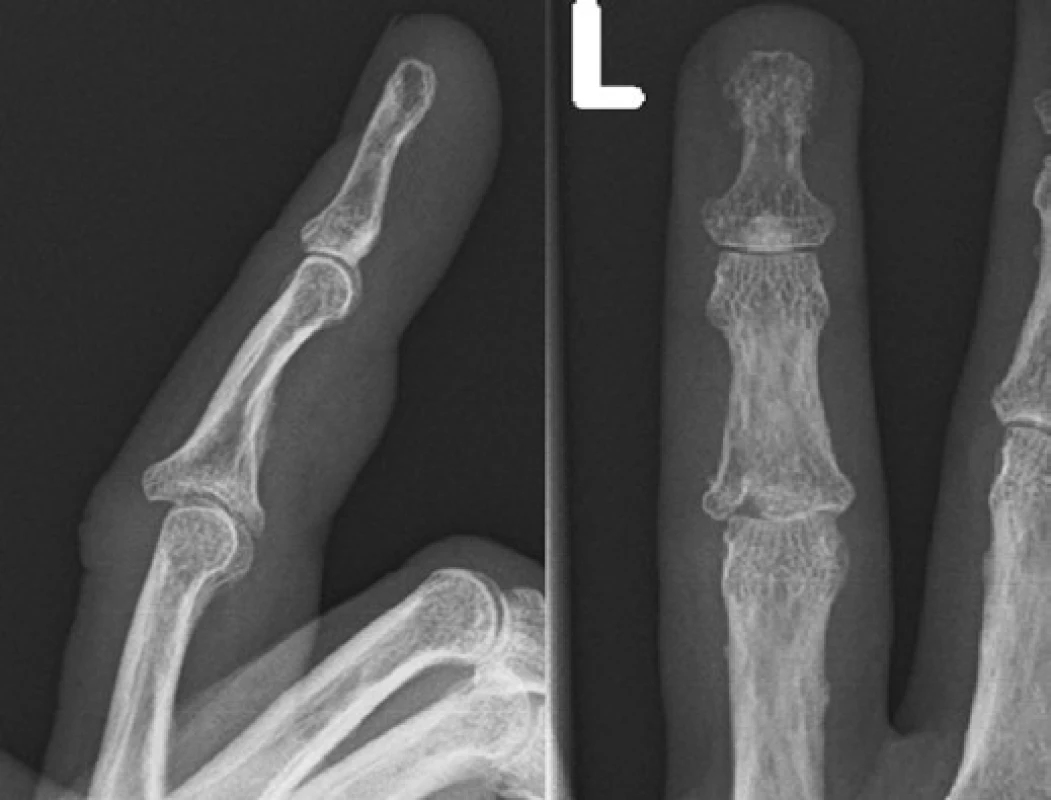
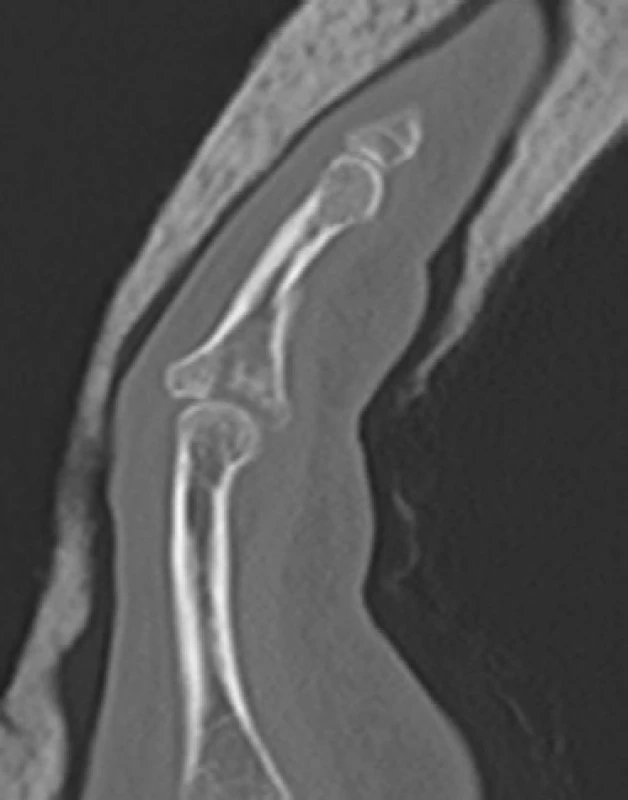
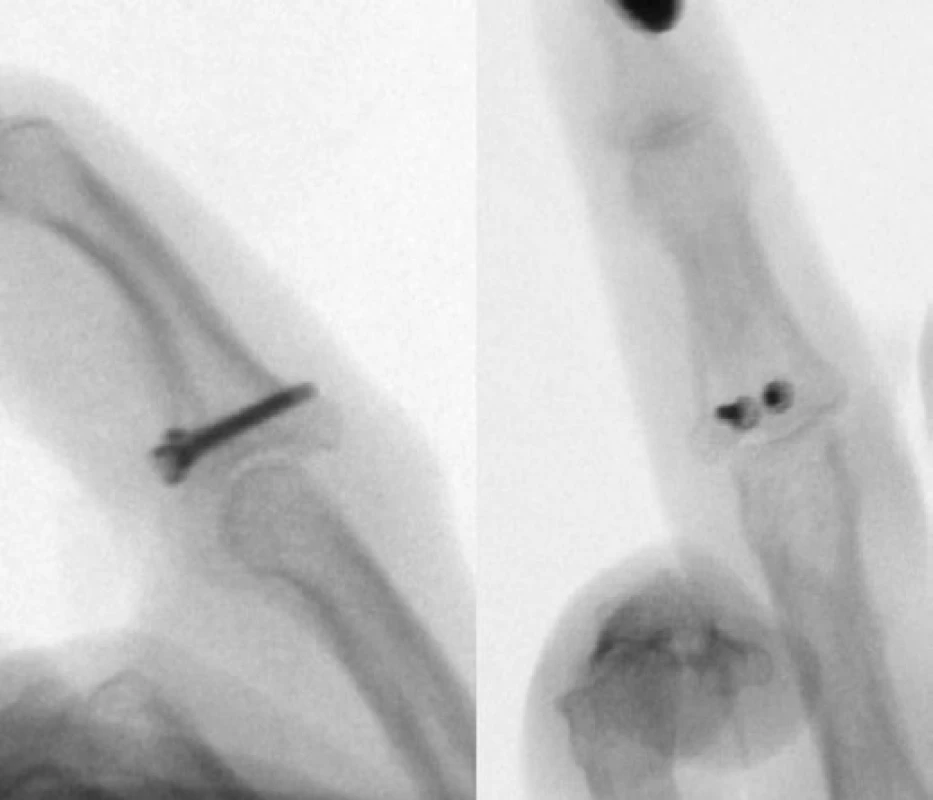
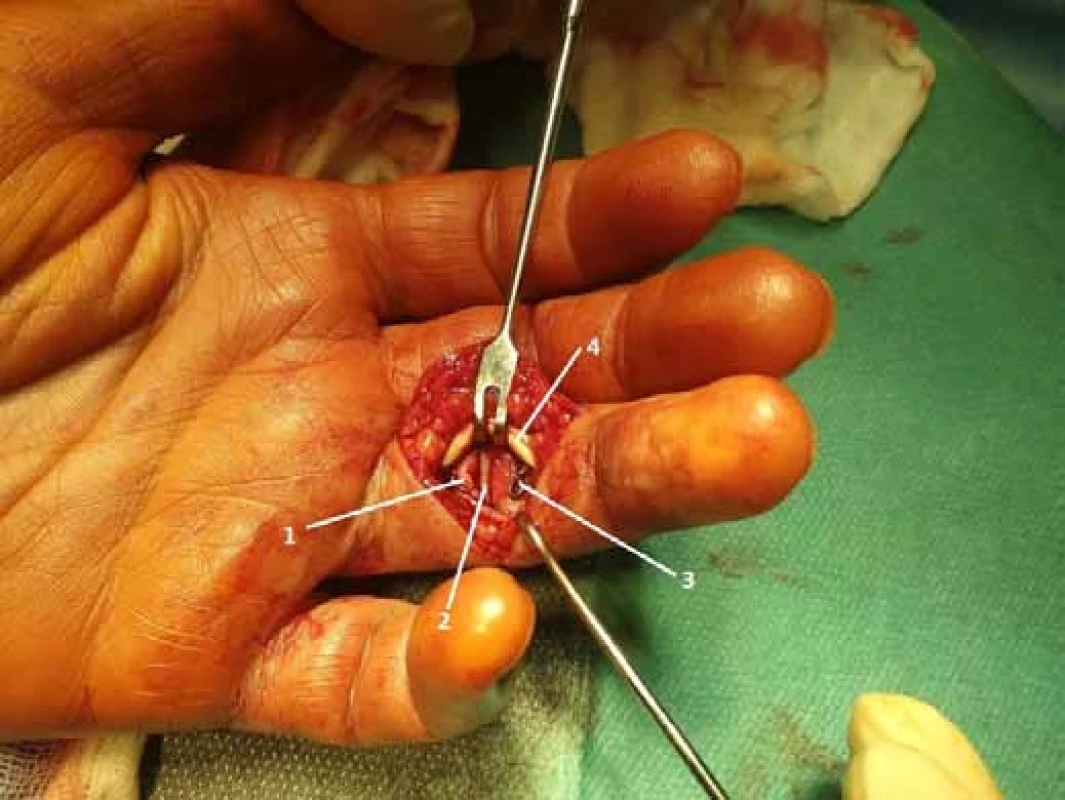
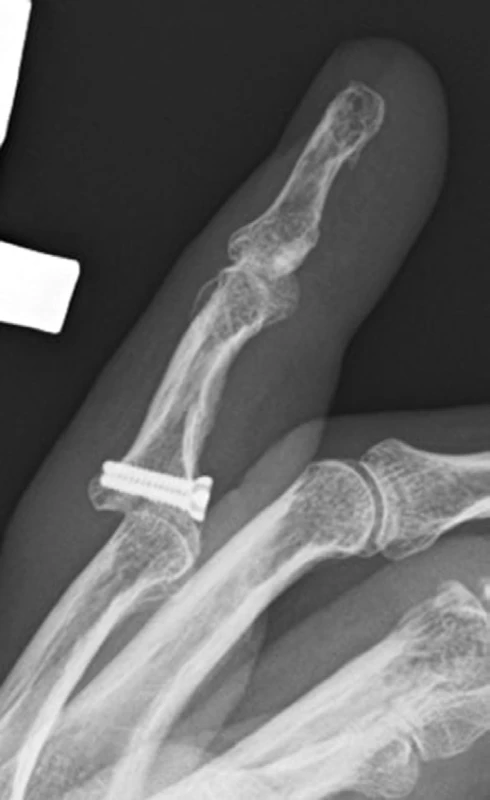
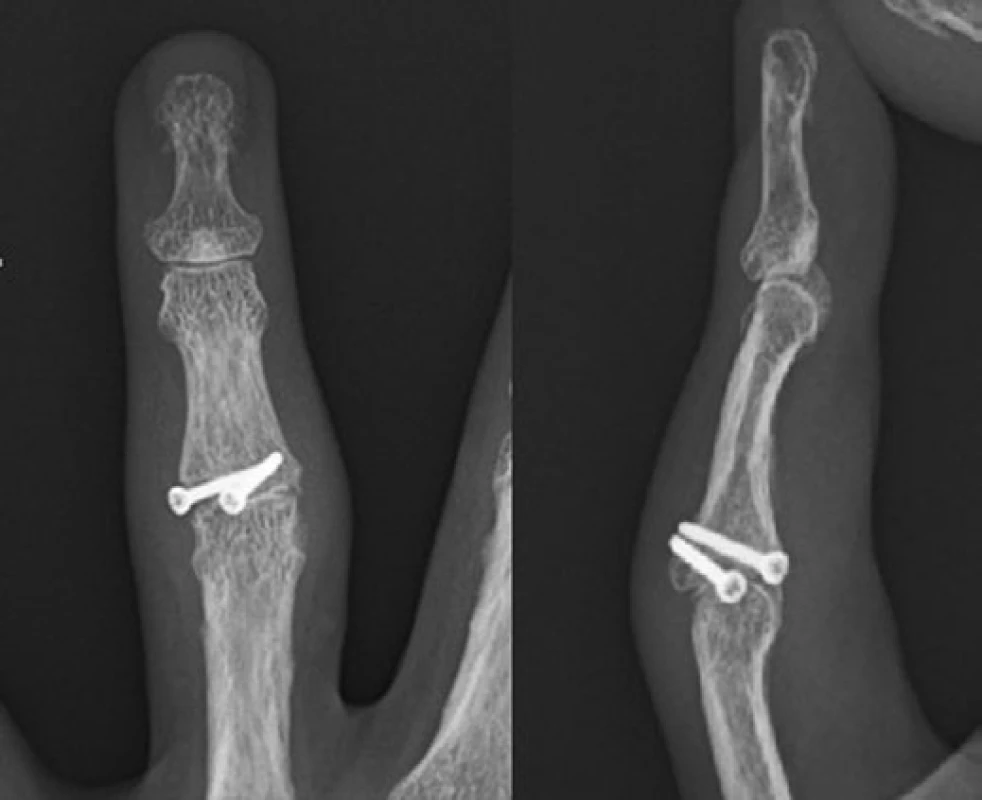
DISCUSSION
Fractures of the base of the middle phalanx of the finger of the hand with luxation or subluxation in the proximal interphalangeal joint include the entire spectrum of injuries. They often occur as sports injuries. They can be divided into fractures of the volar part of the base of the phalanx at the place where the volar plate is attached, with dorsal dislocation of the PIP joint - the most common type. The mechanism of its development is hyperextension of the proximal interphalangeal joint [1, 4]. Less common is the fracture of the dorsal part of the base with insertion of the central band of extensor aponeurosis with volar dislocation in PIP. This type is caused by hyperflexion in the PIP joint, or by a shear mechanism during axial violence acting against the extended PIP joint [1, 2, 4]. Increased axial violence can result in a complex intra-articular fracture, involving both the volar and dorsal fragments, with the comminution and impaction of the articular surface, the so-called pilon fracture [5].
The diagnosis consists of anamnesis, clinical examination and imaging methods, where a simple X-ray is usually sufficient. In case of uncertainty about the nature of the fracture and in the planning of the surgical solution, we indicate a CT scan. In X-ray, AP is necessary and especially accurate lateral projection, without which we are not able to assess the damage to the articular surface and we can easily overlook the injury or underestimate its severity. We evaluate the symmetry of the articular surface and the percentage size of the fragment. Even a slight divergence of articular surfaces (the so-called “V-sign”) indicates instability (Fig. 13). If the fragment reaches 30% of the articular surface, the fracture is stable. With 30-50 % impact on the articular surface, stability is already problematic and when more than 50 % is affected, it is an unstable injury [1]. There is a biomechanical study on cadavers that compares the stability of acute dorsally dislocated fractures in relation to the size of the articular surface damage. It was published by Tyser et al. 2014 [24]. On 18 fingers with artificially generated volar fragments of different sizes (intact, 20 %, 40 %, 60 %, and 80 %) Tyser examined the stability of movement in the PIP joint. The first two groups were stable, the last two were unstable. Stability in 40% of damage was variable and this value appears to be marginal.
![Scheme of so-called V-sign – X-ray sign of subluxation in the joint [16]](https://www.prolekare.cz/media/cache/resolve/media_object_image_small/media/image_pdf/c650daea9c8794f3e89010ab72f1b781.jpeg)
In dorsal dislocation, the degree of flexion in the PIP at which reduction can be maintained is also evaluated. If this is more than 30° flexion it is an unstable injury [2]. Pilon fractures that are dislocated are primarily considered unstable [6].
Stable fractures are treated conservatively. Conservative treatment consists in fixation of the PIP joint in semiflexion for a period of 3 weeks. We use aluminum splint or an extension block. It is also possible to use functional taping to the adjacent finger, so-called buddy-tape. Lunger et al. found no difference in treatment results between extension block and buddy taping [7]. However, a prerequisite is an informed and collaborative patient, and it is necessary to mind the risk of skin lesions on the fingers caused by the tape [8].
Unstable fractures require surgical treatment. Open reduction and stabilization by tension screws is the method of choice for two-fragment fractures without articular surface comminution [1, 4]. Depending on the localization of the fragment, we choose the surgical approach. In the palmar fragment we use the palmar “zigzag” incision, which we penetrate to the flexor, discide the A3 peritenon and pull the tendon away. This uncovers the palmar disc that is attached to the fragment. It is ideally repositioned and fixed by two tensile 1.3 or 1.5 mm screws under X-ray control. We carefully choose the lengths of the screws so that they do not penetrate dorsally and do not tangle the extensor tendon. The ideal visual overview of the articular surface is provided by the shot-gun approach where the proximal insertion of collateral ligaments allows the finger to be inverted into hyperextension (Fig. 14). After the osteosynthesis is complete, the ligaments must be sewn to the volar plate. We interpose a A3 peritenon between the volar disc and flexor tendon and then close the wound. If the osteosynthesis is stable, it enables early active movement.
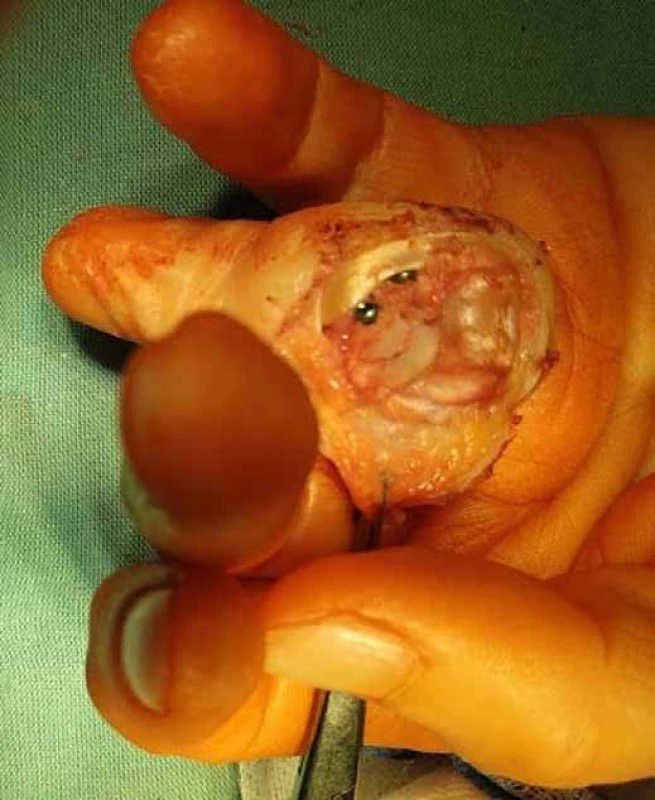
In case of breake-off of the dorsal fragment we use the dorsal approach. Through the S-shaped or arcuate incision we penetrate the extensor apparatus and to the fracture between the lateral and central band. It is important to maintain the central band insertion on the base fragment to prevent buttoniere deformity. After the reduction, we stabilize the fracture again with tension bolts, whose heads are better placed under the lateral bands of the extensor.
In the case of comminutive fractures with articular surface impaction one of the possibilities is to use a dynamic external fixator. This method was first published by Suzuki [9] and his name is also coined for naming this method. The principle is closed repositioning by ligamentotaxis using elastic strokes that cause distraction and specifically introduced Ki wires that reposition the dislocation (Fig. 15). The original design is simple and inexpensive, but of course, there are commercially manufactured prefabricated implants. Fixator allows active finger movement from the first postoperative day. It is removed in 4-6 weeks. Retrospective studies report good results with average flexion achieved in PIP 86-88 dg. [10,11]. However, studies with larger patient cohorts or meta-analyzes are lacking.
![Dynamic external fixation according to Suzuki. The 1st wire passes through the centre of the head of the phalanx base; the second wire through the middle phalanx head, these are connected by elastic bands to allow distraction. The 3rd wire is inserted distally from the fracture and below the 1st wire, preventing dorsal subluxation of the middle phalanx [17]](https://www.prolekare.cz/media/cache/resolve/media_object_image_small/media/image_pdf/a0598a2875b780b16cccee7ff8a320cf.jpeg)
More advanced techniques for the reconstruction of particularly invetered injuries or articular surface comminution injuries include volar plate arthroplasty (VPA) and hemi-hammate arthroplasty (HHA). In 1980, Eaton published his 10 years of experience with the arthroplasty of the volar plate in 24 patients, in 7 cases there were acute injuries, in 17 cases chronic ones [12]. He reports average movement in PIP of 95 dg in the first group, and 78 dg in the second group. The method consists in extirpation of comminutive fragments of the articular surface and reinsertion of the volar disc into the defect and its refixation to middle phalanx by means of a transosseal stitch or mini anchor. The PIP joint is transfixed with the obliquely introduced K wire. This is extracted after 3 weeks and followed-up by RHB (Fig. 16).
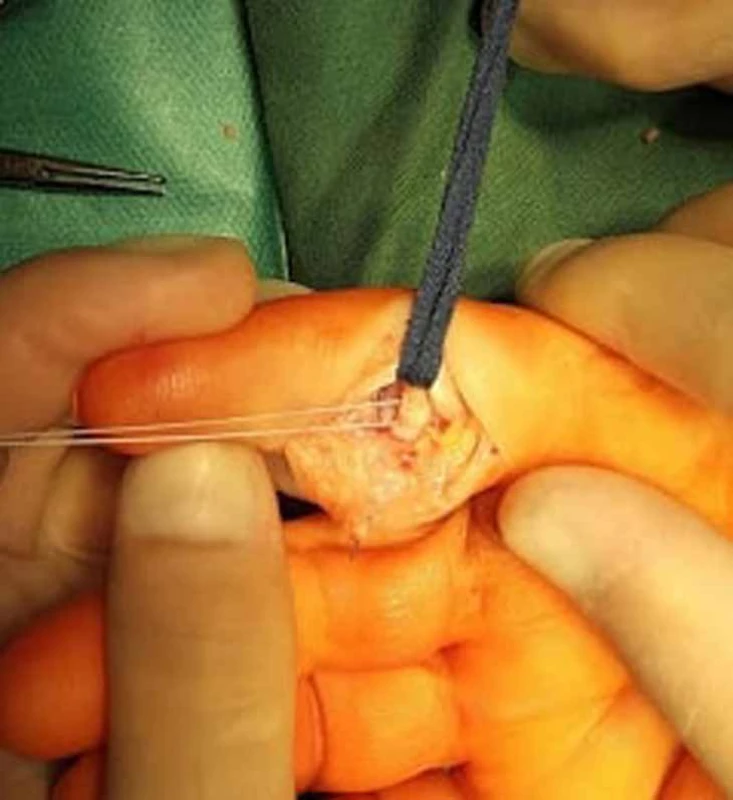
Hemi-hamate arthroplasty, published by Hastings in 1999 [13], is a technically demanding operation that replaces the volar portion of the articular surface of the middle phalanx with an osteochondral graft taken from the dorsal distal portion of the hamatum at the region where the base of IV and V metacarpus adjaces. After processing and shaping, the graft is inserted into the articular surface defect and fixed with two screws (Fig. 17). The literature suggests that in the case of an articular surface comminution of greater extent, this is a better option than arthroplasty with a volar plate [14]. In 2015, Tyser et al. performed a biomechanical comparison of both methods on 18 fingers of cadavers [23]. They observed virtually no dorsal PIP subluxation in full extension in both methods, but there was some degree of flection contracture in all fingers with VPA, none with HHA. Therefore, they concluded that the joint stability can be restored using both methods, but HHA is associated with a lower risk of a flection contracture.
![Schematic of hemi-hammate arthroplasty [22]](https://www.prolekare.cz/media/cache/resolve/media_object_image_small/media/image_pdf/fbc85a37eb1e8d496d5e51b69c97a99e.jpeg)
O‘Rourke et. al. published an 11-year review of the treatment of intra-articular fractures of the phalanges. Of the 17 % of the joints that showed radiological signs of post-traumatic arthritis, only one was symptomatic [20]. However, it is a small group of 59 patients. In any case, with post-traumatic arthrosis already developed, only conservation procedures remain. It is possible to use arthrodesis or alloplasty of the PIP joint [15]. We make decisions on an individual basis resulting from the patient‘s functional requirements. Arthrodesis is selected in patients with high demands on finger load, insufficient joint stability or lacking bone support for implant. Otherwise, arthroplasty is the method of choice ensuring a painless and mobile joint [18]. However, it is an evolving method with a significant number of complications [15, 19, 21]. The description of these methods is beyond the scope of this communication.
CONCLUSION
The treatment of intra-articular dislocation fractures of the base of the middle phalanx of the hand has its specific pitfalls. Quality diagnostics is of paramount importance. Correctly indicated and performed X-ray images are necessary, accurate side projection is required; transverse images and images in gypsum fixation do not suffice. There are criteria and methods for assessing fracture stability. Stable injuries are treated conservatively, we prefer functional therapy. Unstable fractures require surgical treatment. Based on available literature and clinical and biomechanical studies, the following recommendations can be adopted: 1) For simple two-fragment fractures, open reduction and internal fixation is the method of choice. 2) Dynamic external fixation provides good results for comminutive fractures with fragments unsuitable for internal fixation but possible closed repositioning. 3) If a comminution is present but closed reduction is not possible, especially in invetered injuries, we choose between an arthroplasty of a volar plate arthroplasty and a hemi-hammate arthroplasty. HHA provides better results, but is more technically demanding than VPA. The basis of successful treatment is to enable early active movement. Surgical treatment belongs to the hands of an experienced surgeon with adequate material equipment. Despite adequate treatment, full recovery of motion may not always be achieved [1, 2, 3, 4, 14], of which the patient should be advised in advance. The aim of therapy is the patient´s functional and painless finger.
MUDr.Jan Dušátko
Zdroje
- MAŇÁK, P., DRÁČ, P. Osteosyntézy a artrodézy skeletu ruky. Praha : Grada, 2012. ISBN 978-80-247-3873-4
- ELFAR, J., MANN, T. Fracture-dislocations of the Proximal Interphalangeal Joint. Journal of the American Academy of Orthopaedic Surgeons [online]. 2013, 21(2), 88–98 [cit. 2019-10-06]. ISSN 1067-151X. Dostupné z: http://www.jaaos.org/cgi/doi/10.5435/JAAOS-21-02-88
- HAASE, S., Kevin, C., CHUNG, C. Current Concepts in Treatment of Fracture-Dislocations of the Proximal Interphalangeal Joint. Plastic and Reconstructive Surgery [online]. 2014, 134, 1246–1257 [cit. 2019-10-06]. DOI: 10.1097/PRS.0000000000000854. ISSN 0032-1052. Dostupné z: http://content.wkhealth.com/linkback/openurl?sid=WKPTLP:landingpage&an=00006534-201412000-00022
- PILNÝ, J., SLODIČKA, R. Chirurgie ruky. Praha : Grada, 2011. ISBN 978-80-247-3295-4
- KIEFHABER, TR, STERN, PJ. Fracture dislocations of the proximal interphalangeal joint. The Journal of Hand Surgery [online]. 1998, 23, 368–380 [cit. 2019-10-06]. ISSN 03635023. Dostupné z: https://linkinghub.elsevier.com/retrieve/pii/S036350230580454X
- STERN, PJ., ROMAN, RJ, KIEFHABER, TR et al. Pilon fractures of the proximal interphalangeal joint. The Journal of Hand Surgery [online]. 1991, 16, 844–850 [cit. 2019-10-06]. ISSN 03635023. Dostupné z: https://linkinghub.elsevier.com/retrieve/pii/S0363502310801479
- LUNGER, A., LUNGER, L., BACH, A. et al. Frühfunktionelles Management bei Hyperextensionstraumata des proximalen Interphalangealgelenkes mit Läsion der palmaren Platte: Extensionsblock versus Achterschlaufe. Handchirurgie · Mikrochirurgie · Plastische Chirurgie [online]. 2017, 49, 297–303 [cit. 2019-10-06]. ISSN 0722-1819. Dostupné z: http://www.thieme-connect.de/DOI/DOI?10.1055/s-0043-117736
- WON, SH, LEE, S.,CHUNG, CHY, et al. Buddy Taping: Is It a Safe Method for Treatment of Finger and Toe Injuries? Clinics in Orthopedic Surgery [online]. 2014, 6 [cit. 2019-10-06]. ISSN 2005-291X. Dostupné z: https://synapse.koreamed.org/DOIx.php?id=10.4055/cios.2014.6.1.26
- SUZUKI, Y., MATSUNAGA, T., SATO, S et al. The Pins and Rubbers Traction System for Treatment of Comminuted Intraarticular Fractures and Fracture-Dislocations in the Hand. Journal of Hand Surgery [online]. 2016, 19, 98–107 [cit. 2019-10-06]. ISSN 0266-7681. Dostupné z: http://journals.sagepub.com/doi/10.1016/0266-7681%2894%2990059-0
- ABOU ELATTA, MM., ASSAL, F., BASHEER, MH et al. The use of dynamic external fixation in the treatment of dorsal fracture subluxations and pilon fractures of finger proximal interphalangeal joints. Journal of Hand Surgery (European Volume) [online]. 2016, 42, 182187 [cit. 2019-10-06]. Dostupné z: http://journals.sagepub.com/doi/10.1177/1753193416674155
- RULAND, RT., HOGAN, CHJ, CANNON, DL et al. Use of Dynamic Distraction External Fixation for Unstable Fracture-Dislocations of the Proximal Interphalangeal Joint. The Journal of Hand Surgery [online]. 2008, 33, 19–25 [cit. 2019-10-06]. ISSN 03635023. Dostupné z: https://linkinghub.elsevier.com/retrieve/pii/S036350230700648X
- EATON, RG., MALERICH, MM. Volar plate arthroplasty of the proximal interphalangeal joint: A review of ten years‘ experience. The Journal of Hand Surgery [online]. 1980, 5, 260–268 [cit. 2019-10-06]. ISSN 03635023. Dostupné z: https://linkinghub.elsevier.com/retrieve/pii/S0363502380800116
- Hastings, H., Capo, J., Steinberg, B. et al., Hemicondylar hamate replace-ment arthroplasty for proximal interphalangeal joint fracture/disloca-tions. 54th Annual Meeting of the American Society for Surgery ofthe Hand. Boston MA 1999; (Abstract)
- Green, DP., Wolfe, SW. Green‘s operative hand surgery. Philadelphia: Elsevier/Churchill Livingstone.
- HERREN, D. The proximal interphalangeal joint: arthritis and deformity. EFORT Open Reviews [online]. 2019, 4, 254–262 [cit. 2019-10-06]. Dostupné z: https://online.boneandjoint.org.uk/doi/10.1302/2058-5241.4.180042
- AHSAN, ZS, YAO, J. Ligamentous injuries of the hand. Current Orthopaedic Practice [online]. 2012, 23, 313–317 [cit. 2019-10-06]. DOI: 10.1097/BCO.0b013e31825c3690. ISSN 1940-7041. Dostupné z: http://content.wkhealth.com/linkback/openurl?sid=WKPTLP:landingpage&an=01337441-201207000-00010
- NG, CY, OLIVER, CW. Fractures of the proximal interphalangeal joints of the fingers. The Journal of Bone and Joint Surgery. British volume [online]. 2009, 91-B(6), 705–712 [cit. 2019-10-06]. ISSN 0301-620X. Dostupné z: http://online.boneandjoint.org.uk/doi/10.1302/0301-620X.91B6.21953
- KAMNERDNAKTA, S., HUETTEMAN, HE, CHUNG, KC. Complications of Proximal Interphalangeal Joint Injuries. Hand Clinics [online]. 2018, 34, 267–288 [cit. 2019-10-06]. DOI: 10.1016/j.hcl.2017.12.014. ISSN 07490712. Dostupné z: https://linkinghub.elsevier.com/retrieve/pii/S0749071217301968
- NUNLEY, RM., BOYER, MI, GOLDFARB, CHA. Pyrolytic Carbon Arthroplasty for Posttraumatic Arthritis of the Proximal Interphalangeal Joint. The Journal of Hand Surgery [online]. 2006, 31, 1468–1474 [cit. 2019-10-06]. DOI: 10.1016/j.jhsa.2006.07.017. ISSN 03635023. Dostupné z: https://linkinghub.elsevier.com/retrieve/pii/S0363502306008161
- OROURKE, S., GAUR, S., BARTON, N. Long-term outcome of articular fractures of the phalanges: An eleven year follow up. The Journal of Hand Surgery: Journal of the British Society for Surgery of the Hand [online]. 1989, 14, 183–193 [cit. 2019-10-06]. ISSN 02667681. Dostupné z: http://jhs.sagepub.com/cgi/doi/10.1016/0266-7681(89)90123-X
- VITALE, MA., FRUTH, KM, RIZZO, M. et al. Prosthetic Arthroplasty Versus Arthrodesis for Osteoarthritis and Posttraumatic Arthritis of the Index Finger Proximal Interphalangeal Joint. The Journal of Hand Surgery [online]. 2015, 40, 1937–1948 [cit. 2019-10-06]. DOI: 10.1016/j.jhsa.2015.05.021. ISSN 03635023. Dostupné z: https://linkinghub.elsevier.com/retrieve/pii/S0363502315006115
- WILLIAMS, R., Thomas, MM, KIEFHABER, R. et al. Treatment of unstable dorsal proximal interphalangeal fracture/dislocations using a hemi-hamate autograft. The Journal of Hand Surgery [online]. 2003, 28, 856–865 [cit. 2019-10-06]. ISSN 03635023. Dostupné z: https://linkinghub.elsevier.com/retrieve/pii/S0363502303003046
- TYSER, AR., TSAI, MA, PARKS, BG et al. Biomechanical Characteristics of Hemi-Hamate Reconstruction Versus Volar Plate Arthroplasty in the Treatment of Dorsal Fracture Dislocations of the Proximal Interphalangeal Joint. The Journal of Hand Surgery [online]. 2015, 40(2), 329–332 [cit. 2019-10-06]. DOI: 10.1016/j.jhsa.2014.10.061. ISSN 03635023. Dostupné z: https://linkinghub.elsevier.com/retrieve/pii/S036350231401586X
- TYSER, AR., TSAI,MA, PARKS, BG et al. Stability of Acute Dorsal Fracture Dislocations of the Proximal Interphalangeal Joint: A Biomechanical Study. The Journal of Hand Surgery [online]. 2014, 39, 13–18 [cit. 2019-10-06]. DOI: 10.1016/j.jhsa.2013.09.025. ISSN 03635023. Dostupné z: https://linkinghub.elsevier.com/retrieve/pii/S036350231301321X
Štítky
Chirurgie všeobecná Traumatologie Urgentní medicínaČlánek vyšel v časopise
Úrazová chirurgie
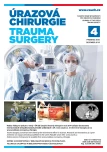
2018 Číslo 4
- Metamizol jako analgetikum první volby: kdy, pro koho, jak a proč?
- Perorální antivirotika jako vysoce efektivní nástroj prevence hospitalizací kvůli COVID-19 − otázky a odpovědi pro praxi
- Stillova choroba: vzácné a závažné systémové onemocnění
- Neodolpasse je bezpečný přípravek v krátkodobé léčbě bolesti
Nejčtenější v tomto čísle
- INTRA-ARTICULAR DISLOCATION FRACTURES OF THE MIDDLE PHALANX BASE - CASE REPORTS OF INCORRECT TREATMENT PROCEDURES, CURRENT TREATMENT CONCEPTS
- Non-unions after intramedullary nailing of fractures of the humeral diaphysis
- Therapeutic results of acromioclavicular dislocations by means of a hook plate and tension wire band
- Conservative and surgical treatment of fractures of articular process of mandible in adults

